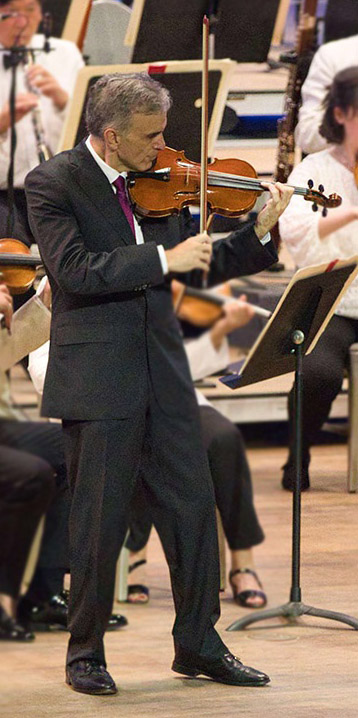

Hearing the Tanglewood premiere of Fanny Mendelssohn-Hensel’s Overture in C Major under Andris Nelsons on Sunday reinforced our belief that Felix’s sister showed exceptional musical talent at a young age. When she was 11, her composition teacher Carl Friedrich Zelter praised her ability to Goethe. Would she have been as great a composer as her brother, had she been able to enter the public sphere? As the philosopher Hilary Putnam was fond of noting, it is hard to argue for or against a counter-factual (“If you had a brother, would he like kreplach?”). Such debates are largely unproductive. Her Overture in C Major, likely composed in 1830-32 and thus contemporary with Felix’s Reformation Symphony, is her only known purely orchestral work. It is composed in a fairly straightforward sonata-allegro form with a slow introduction.
Nelsons gave it a careful but spirited reading. He emphasized the Mozartean touches ― a Mannheim rocket, a stutter-step motif in the transition to the second theme ― and called attention to the clear quote from her brother’s Midsummer Night’s Dream overture in the beautiful second theme. Thundering tympani gave drama at the close, and Elizabeth Rowe’s exquisite flute imbued the piece with yearning, creating a subtle tension with the bold march and rapid tremolos of the coda. If the composer had heard the work performed, she might have revised it in some spots. Or perhaps she refrained deliberately from revealing herself out of a sense of decorum as expected of women of her social standing in that era.
Gil Shaham stepped in to replace the Dutch piano duo Lucas and Arthur Jussen who were to have performed Mozart’s Concerto for Two Pianos and Orchestra in E-flat Major, K. 365, but were unable to travel due to COVID restrictions. Instead we were treated to Mozart’s delightful Violin Concerto No. 3 in G Major, K. 216, written in 1775, perhaps for his fellow violinist Gaetano Brunetti at the Salzburg court. An expansive and playful work, it overflows with melodic inventiveness and notably explores the possibilities of the Rondeau in the final movement.
Nelsons gave the opening G major orchestral theme a light-hearted and slightly martial touch. Shaham entered with a more sober, serious tone. The orchestra gradually coaxed Shaham’s violin into some sort of confession, turning mirthfully and operatically “tragic” in the cadenza. As the ensuing adagio opened with the gently pulsating main theme, Shaham held his hand to his heart in tribute. He then took up the theme in the violin one octave higher, with sweet restraint, evoking a love song. Slowly, Shaham’s lovelorn violin won the empathy of the orchestra, as operatic posturing vanished to give way to genuine intimacy. Shaham’s most memorable moments were the passages of exquisite softness, when the sound seemed almost to vanish but the emotional depth soared. The cadenza felt like an aria, singing of love and memories. Shaham’s violin grew plaintive, but remained magnificently free of artifice.
The lively rocking, swaying, Rondeau now drew Shaham back into the dance of life, climaxing with the folkloric Strassbourgeois theme and its “musette” quality. Shaham stood next to Nelsons as they coordinated the timing carefully. The joyfulness was pure “Age of sensibility”, beautifully natural (as opposed to Baroque) but rooted in wisdom (as opposed to Romantic impulsiveness). Shaham’s wise and understated violin combined perfectly with Nelsons’s intelligent grasp of Mozart’s light-heartedness to give the piece its full impact.
Felix Mendelssohn composed his Symphony in D Major/D Minor on behalf of Emperor Charles V for the 300th anniversary of the presentation of the Augsburg Confession, the primary confession of faith of the Lutheran Church. His sister Fanny gave it the name Reformation Symphony, but for various reasons the festival organizers may have thought it was too symphonic; it did not make it onto the festivities. Mendelssohn tried to have it performed at symphony concerts but there it was seen as too churchy, and Felix seems to have lost faith in the symphony; it was not published until 1868, hence the late cataloging as No. 5, Op. 107.
Nelsons adroitly reconciled its sacred and profane dimensions to give us a coherent experience. The opening came as a dawn heralding a new day, leading to dramatically prophetic horns, then shifting from the firm solid ground of the first theme through a turbulent transition to a prayerful second theme. The development brought opposing forces into juxtaposition, alternating strife, aspiration to freedom, oppression and resolve, until resolve grew firm enough to win the day. Nelsons rendered the ensuing allegro vivace as a celebratory liberation, with hints of pastoral beauty in the trio (Rousseau?), followed by a more affirmative and self-secure return of the A section.
Why, then, did we hear such sadness in the third movement Andante? Nelsons imbued it with the feeling of a lamentation, enhanced by Rowe’s hauntingly compassionate flute in the transition to the final movement. (Was the celebration premature? Is freedom from ecclesiastic tyranny, as such, insufficient to bring humanity to Enlightenment? Is the impulse to kill and to oppress and to destroy too deeply rooted in us?) The magnificent flute solo sounded like a spiritual call to gather and rediscover the safeguards of the sacred. A glorious tutti in the first theme and turbulent currents leading to massive chords in the closing suggested a chastened humanity learning to cooperate for the greater good. Surmounting the bipolarities, Nelsons read Felix’s Reformation Symphony as an urgent goad to harmonize ourselves.
Leon Golub is an astrophysicist at the Center for Astrophysics in Cambridge and has been a lover of classical music for over 50 years.


